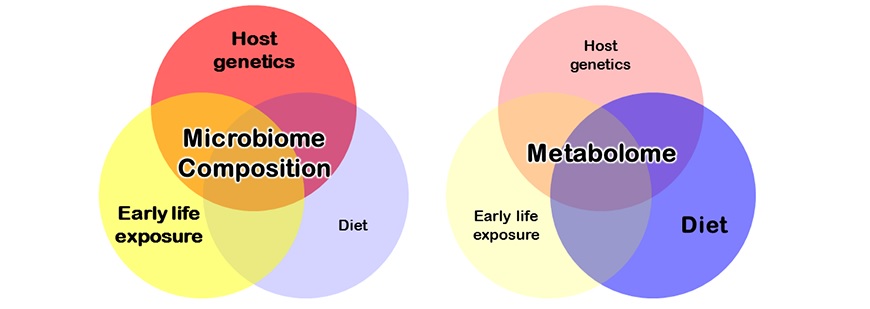Microbiome population diversity is relatively stable throughout the life of a host organism, returning to a durable, individualized baseline after most disruptions. This baseline is established in infancy, through genetic and environmental factors, and appears resistant to changes in diet.
What will change, however, are the metabolites generated by an individual's gut microbiome when this population shifts metabolic pathways in response to diet or environmental conditions. This behavior will, in turn, impact the health and metabolism of the host organism, which suggests new research opportunities in microbiome-focused therapeutics.
Factors Affecting Gut Microbiome Establishment
Studies over the past decade have suggested that the gut microbiome develops early in life and reaches its stable adult state by about three years of life in humans. The state formed at this age is thought to involve a microbiome "set point" which shapes the composition of the gut microbiota throughout life.- Prenatal and perinatal exposure to maternal microbes
- Route of delivery (vaginal vs. cesarean)
- Infant diet (breast vs. formula feeding, onset of solid food)
- Environmental (familial transmission, exposure to environmental microbiota)
- Antibiotic use
- Genetics
Early Life Exposure and Genetics
A recent study by Snijders, et al. supports the conclusion that genetics and early life exposure are critical in determining the composition of the gut microbiome in mice.Scientists from the Department of Energy's Pacific Northwest National Laboratory and Lawrence Berkeley National Laboratory (Berkeley Lab) studied a genetically diverse group of mice that were raised in different facilities. Their findings showed that early life exposure and genetics were the main determinants of microbiome composition, whereas diet had only modest effects.
Furthermore, once these patterns were established, changing diet or housing locations had only minor effects on microbial community diversity.
Diet, Metabolomics, and Diversity
It is becoming clear that the composition of a microbiome (who is there) is perhaps not as important as its metabolic function (what they are doing). Metabolomic profiling of microbial communities is gaining traction in the research community.An interesting finding in the paper by Snijders, et al. was that dietary changes have profound effects on the metabolome, but do not significantly affect microbial diversity. Bacteria are highly adaptable to differing energy sources, such as diet-specific complex carbohydrates and fatty acids, and can produce divergent metabolites as their diet is altered.
This raises the possibility of targeting the microbiome at its functional level for therapeutic interventions - an intriguing strategy given the apparent intractability of altering microbiome composition in a durable fashion.

New Genetic Loci Linked with Microbiome Diversity
While it is clear genetics play a role, little is known regarding how host genetics shape the microbiome. Snijders, et al. characterized the gut microbiota of 30 different mouse strains and used the genetic differences between these mice to identify 169 genetic loci associated with microbiome composition. These loci included genes involved in gastrointestinal cancer, inflammatory diseases, and lipid metabolism.These important new data will help guide scientists in understanding how genetics influence the microbiome.
What Does This Mean for Mouse Model Research?
The microbiome is a critical variable in any mouse study; regardless of whether the microbiome is a direct study objective, its effects deserve consideration and must be controlled.The murine microbiome is established in early life and depends upon familial transmission, the environment, and genetics. Diet also plays a role, particularly in determining function at the metabolomic level.
- Genetic background
- Exposure to equivalent familial and environmental microbiota
- Housing conditions
- Diet
















.jpg)

.jpg)
.jpg)
.jpg)
.jpg)





.jpg)


.jpg)
.jpg)




.jpg)




.jpg)

.jpg)



